Caique Hand Feeding and Weaning
Most chicks are removed from the nestbox for handfeeding about 10 days old, younger if the clutch is large. I seldom allow more than three chicks in the nest, if more than 3 eggs, the oldest chick is removed on the day chick #4 is due to hatch and repeated in the rare instance of more than 4 eggs. Having fewer chicks in the nest at one time puts less strain on the parents and gives the small, newly hatched chicks a better chance at survival. Chicks removed at 10-14 days old are placed in a brooder at 93° where they remain for the next week to ten days. During this period they can initially require up to five feedings per day, depending on how much the parents have "stretched" the crop. The amount fed at each feeding can vary from chick to chick. They are fed until the crop is well rounded, but never tight which can lead to accidental aspiration.
At 3 weeks they are moved to the next brooder which is maintained at 89°-90°. By this time more formula is given at each feeding so the time between feedings is increased and feedings are reduced to 4 times each day. They remain at this temperature and schedule until their pin feathers have started to open at about 4-5 weeks. They are then moved to a covered, unheated brooder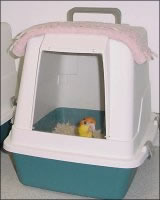 in groups of 3 or 4 chicks at room temperature of about 80° and the number of feedings is reduced to three. If there is only one chick, some supplemental heat may be necessary. They stay in this covered "brooder" until they are almost fully feathered and attempt to fly, at about 7-8 weeks. At this point they are moved to weaning cages where various types of weaning foods are introduced.
in groups of 3 or 4 chicks at room temperature of about 80° and the number of feedings is reduced to three. If there is only one chick, some supplemental heat may be necessary. They stay in this covered "brooder" until they are almost fully feathered and attempt to fly, at about 7-8 weeks. At this point they are moved to weaning cages where various types of weaning foods are introduced.
Formula
There are many fine commercial handfeeding formulas available today. I have used Kaytee Exact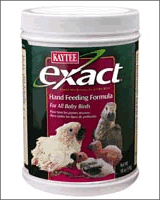 handfeeding formula exclusively since 1990.
For best results in raising baby Caiques I use Kaytee (regular, not Macaw) handfeeding formula, 5 lbs mixed with 1 lb (1/2 of a 1kg box) of CéDé Lorifood or CéDé Handrearing Food.
handfeeding formula exclusively since 1990.
For best results in raising baby Caiques I use Kaytee (regular, not Macaw) handfeeding formula, 5 lbs mixed with 1 lb (1/2 of a 1kg box) of CéDé Lorifood or CéDé Handrearing Food.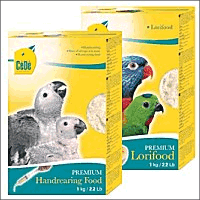 The product is the same, it is just packaged differently for alternative uses. The CéDé is rice based and is very easily digested. The addition of the CéDé improves the texture as I find the Kaytee alone to be coarse and gritty. A small amount of Papaya or Mango babyfood or pureed fresh can be added to each feeding to improve texture and taste as well as for the natural digestive enzymes.
The product is the same, it is just packaged differently for alternative uses. The CéDé is rice based and is very easily digested. The addition of the CéDé improves the texture as I find the Kaytee alone to be coarse and gritty. A small amount of Papaya or Mango babyfood or pureed fresh can be added to each feeding to improve texture and taste as well as for the natural digestive enzymes.
The formula is made fresh each feeding, prepared according to the manufacturers directions and fed at between 105° and 108°.
Weaning
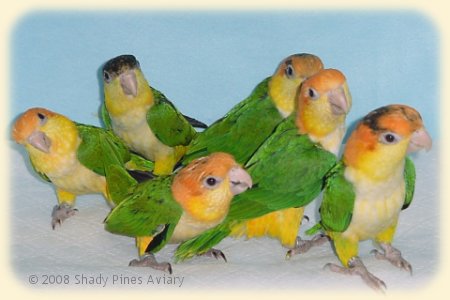 Caiques tend to learn by example and benefit from being raised in a group. A single chick will often take much longer to wean. Once in the weaning cage, many different foods are offered which include the same seed, pellets, spray millet, vegetable/sprout mixture and assorted fresh fruits given to the adults.
Caiques tend to learn by example and benefit from being raised in a group. A single chick will often take much longer to wean. Once in the weaning cage, many different foods are offered which include the same seed, pellets, spray millet, vegetable/sprout mixture and assorted fresh fruits given to the adults.
As the youngsters begin to sample and eat the various weaning foods, the amount of formula fed at each feeding is reduced. Formula is continued to be offered three times daily until they are fully weaned. Often at feeding time their crops are already full of weaning foods and formula is refused.
Each afternoon weaning babies are given
soaked Zupreem Primate Biscuits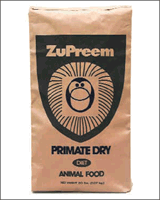 (aka monkey chow). The soaked biscuits are readily accepted and eventually replace the mid-day formula feeding. Several weeks worth are sent home with the babies as "transition" food.
(aka monkey chow). The soaked biscuits are readily accepted and eventually replace the mid-day formula feeding. Several weeks worth are sent home with the babies as "transition" food.
Many weaning babies can lose up to 15% of their pre-weaning weight. This is nature's way of letting them "slim down" in preparation for flight. Most juveniles will put most of that weight back on in their first year. Weaning is usually completed by 13-14 weeks of age.
I encourage families to share with their birds the healthy portion of their meals to include pasta, rice, cooked veggies, beans, a smidgen of well cooked beef, chicken or pork. Also any and all other types of fruits (no Avocado) and veggies that I have not mentioned but have listed in the Avian Nutrition Brochure that goes home with each baby. I recommend making birdie bread using Jiffy Corn muffin mix as a base and letting your imagination go wild with additives.
To summarize, a healthy bird's tastes will change day to day, week to week. A favored food this week may be tossed the next, get inventive and never give up offering healthy choices.
Parent Raised Caique Chicks
On a few occasions I have left the two youngest chicks in the nest to be raised by the parents. They generally fledge at about ten weeks of age although they will still be fed by their parents and continue to sleep in the nestbox. A close watch must be kept on the behavior of the parents toward the chicks. The male parent may be aggressive toward the chicks. If the hen starts to lay another clutch of eggs, she also may be hostile toward her offspring in an effort to evict them from the nestbox.
Next: Banding and Record Keeping
Copyright © 1998-2008 Shady Pines Aviary - No part of this page may be reproduced without the express permission of the author.
